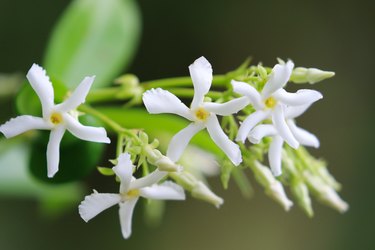
Star jasmine (also known as confederate jasmine or Trachelospermum jasminoides, USDA plant hardiness zones 7b through 10) is a hardy vine that blooms with showy, fragrant flowers. Star jasmine is a disease-resistant plant, and it is tolerant of some drought after it is mature. However, it can suffer from some environmental factors that can lead to jasmine buds turning brown.
Star Jasmine Basic Information
Video of the Day
Star jasmine is a vine that can climb a trellis or act as ground cover. In the United States, this plant grows best in the southern region because it likes warmer temperatures. Day temperatures for jasmines should be from 68 to 72 degrees Fahrenheit, while night temperatures can dip to around 50 to 55 degrees.
Video of the Day
Although it will be fairly drought-resistant as a mature plant, star jasmine benefits from a thorough watering whenever the soil is dry 1 inch below the surface. Slow watering is best, as it allows the soil to deeply absorb moisture.
Star jasmine is fairly disease- and pest-resistant. However, it can be affected by problems with watering, temperature, sunlight and stress. Proper care is essential to ensure you grow a stunning and healthy jasmine plant.
Jasmine Flowers Turning Brown Due to Improper Watering
Overwatering or underwatering a star jasmine plant can make the leaves and blossoms turn brown, develop spots or fall off. If your plant needs a little extra water, create a small berm (a small ridge) in a donut shape around the plant that is 2 to 3 inches high. This berm helps to trap rainwater and let it seep slowly into the ground. The berm can be removed after one or two growing seasons.
A star jasmine that is underwatered may benefit from a drip hose, which you can bury in the soil near the plant. You can deep-water the plant once a month in hot summer heat using the drip hose.
If your star jasmine is in a pot, it may need more frequent watering. Terra-cotta pots can leach out water, so you can submerge the pot in a bucket of water every two to three weeks for 20 minutes. This forces out air pockets from the soil around your plant's roots.
Jasmine Flowers Turning Brown Due to
Sunlight and Stress
If it is inside, star jasmine needs at least four hours of sunshine every day, or 14 to 16 hours of strong artificial light. However, when outdoors, sunshine and heat are not a good combination for this plant. When the plant receives too much of both, it can develop sunburn and heat scorch. Sunburn is the result of too many solar rays and heat. Sunburn shows up as silvery patches in the middle or on the edge of leaves. If the entire plant is wilting or turning brown, it may be a victim of heat scorch. If either malady is affecting the plant, leaves will stay on for a while and then drop off.
You may want to leave the dead leaves on your plant so they can shade the rest of the plant until the weather tones down its heat. Pruning is best done twice a year – once after the spring blooms are finished and once in the late summer or early fall.
Like people, star jasmine plants are susceptible to stress. This can be a result of transplant shock or another jolt to the plant's system. Leaves may turn yellow, and blossoms can turn brown when this is the case. If you continue to properly water the plant and make sure that it gets good sunlight, your plant will likely return to its normal, healthy state within a few weeks.